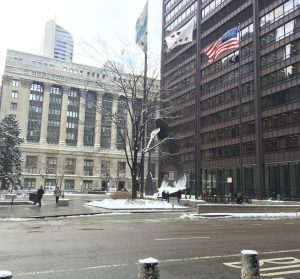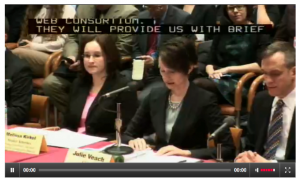Story by Jamie Morgan
Before blue light cameras were erected along Chicago Avenue, store owners on this main street in the 27th Ward used to witness gang and drug activity right outside their doors. Now, those same store owners have seen crime go down since the Chicago Police Department lined the street with cameras.
Not everyone likes the cameras, however. Some residents of the Westside ward’s Humboldt and East Garfield neighborhoods say the cameras have detoured crime rather than deterring it.
“They’re leaving the commercial areas,” says Sobeida Sierra, who works in the ward and lives close by. “But now they’re going inside the residences and (on) smaller streets.”
Now, residents say, in some parts of the ward gang activity happens in front of children walking to school and workers waiting for the bus.
The cameras, part of a 2004 initiative by Mayor Richard Daley, were added to city neighborhoods most troubled by drugs. Police Superintendent Philip J. Cline and the mayor praise the cameras, saying they’ve helped officers make several narcotics arrests. Drug activity is down 60 percent on the corners where there are cameras, according to the Chicago Police Department.
Still, some residents of the 27th Ward say kinks need to be worked out.
Debra Woods, secretary for the 700 Block Club in the ward, says the cameras scare criminals away, but only for a while.
“It seems that it dies down for maybe a couple of months,” Woods says. “And then you’ll see activity pick up in a new spot heavier in the next couple of months.”
She’s noticed crime pick up on Christiana Avenue and Ohio Street since a camera was installed a couple of blocks away.
Although she has misgivings, that hasn’t stopped Woods from requesting a camera for her corner on Christiana and Chicago avenues – she doesn’t want crime pushed into her neighborhood.
Woods says for the program to match the gangs and drug-dealers intelligence system, the Chicago Police Department would probably have to put up a camera on every block.
Since that’s not possible financially, officials and groups have come up with their own solutions to the narcotics problem in the city’s predominately Latino and black neighborhoods.
Ald. Walter J. Burnett Jr. says that crime is embedded in the Westside communities of his 27th Ward.
“It’s inside the houses,” he says. “It’s in the families. It’s challenging to eradicate, but we’re working on it.”
Since being elected alderman 12 years ago, Burnett has worked to fill in vacant lots with businesses in an effort to provide jobs for an employment-hungry community.
Bill Howard, director of the West Humboldt Park Family and Community Development Council, says drug sales are up because employment is down.
“If they really did feel they were part of the community, they would get better jobs and not sell drugs to get money that way.”
Woods takes a different approach to ending future gang and narcotic crimes: Start with the future.
“At one point, the area was so bad, kids literally could not come outside and play.”
She says kids riding their bikes to corner stores is even a safety issue.
She wants to provide more productive, not to mention legal, opportunities to the area’s children. Halloween parties, painting murals and gardening are all ideas in the works to counteract crime.
“Our block club has become so focused on the drugs and violence,” Woods says. “We kind of lost sight of the children.”
At a recent block club meeting, there was discussion of a possible neighborhood art project through Little City, a program for orphans and children with special needs. Corinne M. Pierog directs Little City’s Center for the Arts at its new office on Sacramento Avenue.
Pierog says that projects like creating banners to put around the city gives neighbors a chance to bond.
“It’s something people can gather together to do,” she says. “But what’s neat about it is that it’s an outside thing that everybody can see.
The 900 Block Club members found the best way for them to push crime off their corners was to stand on the corners themselves.
Allie Burks, a retiree and active block club member on Avers Avenue, was part of a month-long “clean-up” of drugs and gangs around her house. She proudly boasts her block has been clean for five years.
“This was in the cold of November when we started it,” she says. “We got some brooms and shovels like we were cleaning the corner. And those guys threatened us. We went there every evening, and we let them know it wasn’t going to be done [here].”
She says even police detectives would join in once in a while. But it was the group of men, women and children that drove the gangs and drugs from her block.
Today, Burks says it’s as a quiet as a cemetery, and her corner on Avers Avenue and Agusta Boulevard has no camera.
She believes the cameras don’t stop crime, citing a corner on Hamlin Avenue where people do whatever they want.
“It comes from the neighbors,” Burks says. “They are the ones who have to not allow it in here. You just have to stand up where you pay your taxes. That’s your residence, and you don’t let nobody come in and tear it down.”
Categories:
City Life Justice & Crime Public West Side
Tags:
27th ward cameras drugs east garfield humboldt park west humboldt park






Be First to Comment